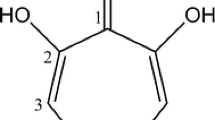Abstract
The ability of a siderophore-catabolizing bacterium to assimilate ferric ion was examined. While the bacterium utilizes the siderophore deferrioxamine B (DFB) as a carbon source, it was incapable of using the ferricion analogue (ferrioxamine B) as an iron source. It did, however, assimilate the ferric ion of the chelator ferric nitrilotriacetic acid and of the siderophore ferrirhodotorulic acid (ferriRA). Neither ferriRA nor its deferrated analog (RA), however, were capable of functioning as carbon sources for the bacterium. The microbe thus employs a ‘nutritional selectivity’ with respect to these two siderophores. That is, it does not use the siderophore it employs as a carbon source (DFB) as an iron source nor does the siderophore utilized as an iron source, i.e. ferriRA, nor its deferrated analog (RA), serve as carbon sources for the organism.
Similar content being viewed by others
References
Atkin CL, Neilands JB. 1968 Rhodotorulic acid, a diketopiperazine dihydroxamic acid with growth factor activity. I. Isolation and characterization. Biochemistry 7, 3734–3739.
Atkin CL, Neilands JB, Phaff HJ. 1970 Rhodotorulic acid from species of Leucosporidium, Rhodosporidium, Rhodotorula, Sporidiobolus, and Sporobolmyces, and a new alanine-containing ferrichrome from Cryptococcus melibiosum. J Bacteriol 103, 722–733.
Bachhawat AK, Ghosh S. 1987 Iron transport in Azos- pirillum brasilense: role of the siderophore spirilobactin. J Gen Microbiol 133, 1759–1766.
Bailey CT, Kime-Hunt EM, Carrano CJ, Huschka H-G, Winkelmann G. 1986 A photoaffinity label for the siderophore-mediated iron transport system in Neurospora crassa. Biochim Biophys Acta 883, 299–305.
Carrano CJ, Bailey CT, Bonadies. 1986 Tatransport properties of N-acyl derivatives of the coprogen and ferrichrysin classes of siderophores in Neurospora crassa. Arch Microbiol 146, 41–45.
Castignetti D, Siddiqui AS. 1990 The catabolism and heterotrophic nitrification of the siderophore deferrioxamine B. Biol Met 3, 197–203.
Castignetti D, Smarrelli J. 1986 Siderophores, the iron nutrition of plants and nitrate reductase. FEBS Lett 209, 147–151.
Castignetti D, Yanong R, Gramzinski R. 1985 Substrate diversity of an active heterotrophic nitrifier, an Alcaligenes sp. Can J Microbiol 31, 441–445.
Davey EW, Gentile JH, Erickson SJ, Betzer P. 1970 Removal of trace metals from marine culture media. Limnol Oceanogr. 15, 486–488.
DeWeger LA, van Arendonk JJ, Recourt K, van der Hofstad GA, Weisbeek PJ, Lugtenberg B. 1988 Siderophore-mediated uptake of Fe3+ by the plant growth-stimulating Pseudomonas putida strain WCS358 and by other rhizosphere microorganisms. J Bacteriol 170, 4693–4698.
Ecker DJ, Matzanke BF, Raymond KN. 1986 Recognition and transport of ferric enterobactin in Escherichia coli. J Bacteriol 167, 666–673.
Emery T. 1982 Iron metabolism in humans and plants. Am Sci 70, 626–632.
Ernst J, Winkelmann G. 1974 Uptake of iron by Neurospora crassa. IV. Iron transport properties of semisynthetic coprogen derivatives. Arch Microbiol 100, 271–282.
Fekete F, Chadhoke V, Jellison J. 1989 Iron-binding compounds produced by wood-decaying basidiomycetes. Appl Environ Microbiol 55, 2720–2722.
Huschka H, Naegeli HU, Leuenberger-Ryf H, Keller-Schierlein W, Winkelmann G. 1985 Evidence for a common siderophore transport system in the presence of different siderophore receptors in Neurospora crassa. J Bacteriol 162, 715–721.
Lammers PJ, Sanders-Loehr J. 1982 Active transport of ferric schizokinen in Anabaena sp. J Bacteriol 151, 288–294.
Leong S, Neilands JB. 1982 Siderophore production by phytopathogenic microbial species. Arch Biochem Biophys 218, 351–359.
Lodge JS, Emery T. 1984 Anaerobic iron uptake by Escherichia coli. J Bacteriol 160, 801–804.
Meyer J-M, Hohnadel D. 1992 Use of nitrilotriacetic acid (NTA) by Pseudomonas species through iron metabolism. Appl Microbiol Biotechnol 37, 114–118.
Mielczarek EV, Royt PW, Toth-Allen J. 1989 Microbial acquisition of iron. Comments Mol Cell Biophys 6, 1–30.
Neilands JB. 1982 Microbial envelope proteins related to iron. Annu Rev Microbiol 36, 285–309.
Neilands JB, Leong SA. 1986 Siderophores in relation to plant growth and disease. Annu Rev Plant Physiol 37, 187–208.
Powell PE, Cline GR, Reid CP, Szaniszlo PJ. 1980 Occurrence of hydroxamate siderophore iron chelators in soils. Nature 287, 833–834.
Raymond KN, Muller G, Matzanke BF. 1984 Complexation of iron by siderophores: a review of their solution and structural chemistry and biological function. Topics Curr Chem 123, 49–102.
Rosenberg H. 1979 Transport of iron into bacterial cells. Methods Enzymol 56, 388–394.
Schwyn B, Neilands JB. 1987 Universal chemical assay for the detection and determination of siderophores. Anal Biochem 160, 47–56.
Sillen LG, Martell AE. 1964 Stability Constants of Metal-Ion Complexes. Special publication 17. London: The Chemical Society.
Villavicencio M, Neilands JB. 1965 An inducible ferri-chrome-A-degrading peptidase from Pseudomonas FC-1. Biochemistry 4, 1092–1097.
Warren RAJ, Neilands JB. 1964 Microbial degradation of ferrichrome compounds. J Gen Microbiol 35, 459–470.
Warren RAJ, Neilands JB. 1965 Mechanism of microbial catabolism of ferrichrome A. J Biol Chem 240, 2055–2058.
Author information
Authors and Affiliations
Additional information
This paper is dedicated to the memory of Professor Thomas Emery. Professor Emery was instrumental in giving support and advice at a time when such mentorship greatly aided the corresponding author in developing a program concerning the catabolism of siderophores by microbes.
Rights and permissions
About this article
Cite this article
DeAngelis, R., Forsyth, M. & Castignetti, D. The nutritional selectivity of a siderophore-catabolizing bacterium. Biometals 6, 234–238 (1993). https://doi.org/10.1007/BF00187761
Received:
Accepted:
Issue Date:
DOI: https://doi.org/10.1007/BF00187761




